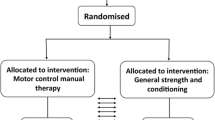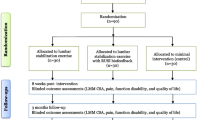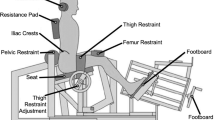Abstract
Background context
Muscle, bone and tendon respond anabolically to mechanical forces. Whether the intervertebral disc (IVD) can benefit from exercise is unclear.
Purpose
To examine whether exercise can beneficially affect IVD characteristics.
Study design/setting
This is a single-blinded 6-month randomised controlled trial (ACTRN12615001270505) in an exercise and physiotherapy clinic.
Patient sample
Forty patients with chronic non-specific low back pain (NSCLBP) are included in this study.
Outcome measures
The primary outcome was lumbar IVD T2 time (MRI). Secondary outcomes included IVD diffusion coefficient and IVD expansion with short-duration lying.
Methods
Twenty patients progressively loaded their lumbar IVDs (exercise) via an exercise programme involving progressive upright aerobic and resistance exercises targeting the trunk and major muscle groups and were compared to twenty patients who performed motor control training and manual therapy (control). Testing occurred at baseline, 3 months and 6 months.
Results
Seventeen exercise and fifteen control patients completed the interventions. There were no group-by-time differences in T2 time of the entire IVD (exercise 94.1 ± 10.0 ms vs. control 96.5 ± 9.3 ms, p = 0.549). Exercise patients had shorter T2 time in the posterior annulus at 6 months (82.7 ± 6.8 ms vs. 85.1 ± 8.0 ms, p = 0.028). Exercise patients showed higher L5/S1 apparent diffusion coefficients and decreased IVD height at 3 months (both p ≤ 0.050). After adjustments for multiple comparisons, differences lost statistical significance. Per-protocol and intent-to-treat analyses yielded similar findings.
Conclusions
This trial found that 6 months of exercise did not benefit the IVD of people with NSCLBP. Based on this index study, future studies could investigate the effect of exercise on IVD in different populations, with different types, durations and/or intensities of exercise, and using different IVD markers.
Graphic abstract
These slides can be retrieved under Electronic Supplementary Material.




Similar content being viewed by others
References
Hawley JA (2008) Specificity of training adaptation: Time for a rethink? J Physiol 586:1–2
Wolff J (1892) The law of bone remodeling (Das gesetz der transformation der knochen). Springer, Berlin
Schoenfeld BJ, Ogborn D, Krieger JW (2016) Effects of resistance training frequency on measures of muscle hypertrophy: a systematic review and meta-analysis. Sports Med 46:1689–1697
Polidoulis I, Beyene J, Cheung A (2012) The effect of exercise on pQCT parameters of bone structure and strength in postmenopausal women—A systematic review and meta-analysis of randomized controlled trials. Osteoporos Int 23:39–51
Marques EA, Mota J, Carvalho J (2012) Exercise effects on bone mineral density in older adults: a meta-analysis of randomized controlled trials. Age 34:1493–1515
Bohm S, Mersmann F, Arampatzis A (2015) Human tendon adaptation in response to mechanical loading: a systematic review and meta-analysis of exercise intervention studies on healthy adults. Sports Med Open 1:7
Belavý DL, Albracht K, Bruggemann G-P, Vergroesen P-PA, van Dieën JH (2016) Can exercise positively influence the intervertebral disc? Sports Med 46:473–485
Chan SC, Ferguson SJ, Gantenbein-Ritter B (2011) The effects of dynamic loading on the intervertebral disc. Eur Spine J 20:1796–1812
Iatridis JC, MacLean JJ, Roughley PJ, Alini M (2006) Effects of mechanical loading on intervertebral disc metabolism in vivo. J Bone Joint Surg Am 88(Suppl 2):41–46
Holm S, Nachemson A (1983) Variations in the nutrition of the canine intervertebral disc induced by motion. Spine 8:866–874
Brisby H, Wei AQ, Molloy T, Chung SA, Murrell GA, Diwan AD (2010) The effect of running exercise on intervertebral disc extracellular matrix production in a rat model. Spine 35:1429–1436
Sasaki N, Henriksson HB, Runesson E, Larsson K, Sekiguchi M, Kikuchi S, Konno S, Rydevik B, Brisby H (2012) Physical exercise affects cell proliferation in lumbar intervertebral disc regions in rats. Spine 37:1440–1447
Ueta RHS, Tarini VAF, Franciozi CES, Tamaoki MJS, Medeiros VP, Nader HB, Faloppa F (2018) Effects of training and overtraining on intervertebral disc proteoglycans. Spine 43:E1–E6
Luan S, Wan Q, Luo H, Li X, Ke S, Lin C, Wu Y, Wu S, Ma C (2015) Running exercise alleviates pain and promotes cell proliferation in a rat model of intervertebral disc degeneration. Int J Mol Sci 16:2130–2144
Marinelli NL, Haughton VM, Munoz A, Anderson PA (2009) T2 relaxation times of intervertebral disc tissue correlated with water content and proteoglycan content. Spine 34:520–524
Belavy DL, Quittner MJ, Ridgers N, Ling Y, Connell D, Rantalainen T (2017) Running exercise strengthens the intervertebral disc. Sci Rep 7:45975
Tagliaferri SD, Miller CT, Owen PJ, Mitchell UH, Brisby H, Fitzgibbon B, Masse-Alarie H, Van Oosterwijck J, Belavy DL (2019) Domains of chronic low back pain and assessing treatment effectiveness: A clinical perspective. Pain Pract 20:211–225
American College of Sports Medicine (2017) ACSM's guidelines for exercise testing and prescription. Lippincott Williams & Wilkins, Philadelphia, USA
Owen PJ, Miller CT, Mundell NL, Verswijveren SJ, Tagliaferri SD, Brisby H, Bowe SJ, Belavy DL (2019) Which specific modes of exercise training are most effective for treating low back pain? Network meta-analysis. Br J Sports Med. https://doi.org/10.1136/bjsports-2019-100886
Le Maitre CL, Frain J, Fotheringham AP, Freemont AJ, Hoyland JA (2008) Human cells derived from degenerate intervertebral discs respond differently to those derived from non-degenerate intervertebral discs following application of dynamic hydrostatic pressure. Biorheology 45:563–575
Wiesinger HP, Kosters A, Muller E, Seynnes OR (2015) Effects of increased loading on in vivo tendon properties: A systematic review. Med Sci Sports Exerc 47:1885–1895
Belavy DL, Quittner M, Ling Y, Connell D, Rantalainen T (2018) Cervical and thoracic intervertebral disc hydration increases with recumbency: A study in 101 healthy volunteers. Spine J 18:314–320
Simson KJ, Miller CT, Ford J, Hahne A, Main L, Rantalainen T, Teo WP, Teychenne M, Connell D, Trudel G, Zheng G, Thickbroom G, Belavy DL (2017) Optimising conservative management of chronic low back pain: Study protocol for a randomised controlled trial. Trials 18:184
Ohnhaus EE, Adler R (1975) Methodological problems in the measurement of pain: A comparison between the verbal rating scale and the visual analogue scale. Pain 1:379–384
Fritz JM, Irrgang JJ (2001) A comparison of a modified oswestry low back pain disability questionnaire and the Quebec back pain disability scale. Phys Ther 81:776–788
Exercise & Sports Science Australia (2019) What is an accredited exercise physiology? https://www.essa.org.au/Public/Consumer_Information/What_is_an_Accredited_Exercise_Physiologist_.aspx. Accessed 18/03/2019
Wilke HJ, Neef P, Caimi M, Hoogland T, Claes LE (1999) New in vivo measurements of pressures in the intervertebral disc in daily life. Spine 24:755–762
Benjamini Y, Hochberg Y (1995) Controlling the false discovery rate - A practical and powerful approach to multiple testing. J R Stat Soc B 57:289–300
Borm GF, Fransen J, Lemmens WA (2007) A simple sample size formula for analysis of covariance in randomized clinical trials. J Clin Epidemiol 60:1234–1238
Glüer C-C, Blake G, Lu Y, Blunt B, Jergas M, Genant H (1995) Accurate assessment of precision errors: How to measure the reproducibility of bone densitometry techniques. Osteoporos Int 5:262–270
Antoniou J, Pike GB, Steffen T, Baramki H, Poole AR, Aebi M, Alini M (1998) Quantitative magnetic resonance imaging in the assessment of degenerative disc disease. Magn Reson Med 40:900–907
Mwale F, Iatridis JC, Antoniou J (2008) Quantitative MRI as a diagnostic tool of intervertebral disc matrix composition and integrity. Eur Spine J 17:S432–S440
Antoniou J, Demers CN, Beaudoin G, Goswami T, Mwale F, Aebi M, Alini M (2004) Apparent diffusion coefficient of intervertebral discs related to matrix composition and integrity. Magn Reson Imaging 22:963–972
Beattie PF, Morgan PS, Peters D (2008) Diffusion-weighted magnetic resonance imaging of normal and degenerative lumbar intervertebral discs: A new method to potentially quantify the physiologic effect of physical therapy intervention. J Orthop Sports Phys Ther 38:42–49
Tyrrell AR, Reilly T, Troup JD (1985) Circadian variation in stature and the effects of spinal loading. Spine 10:161–164
Bowden JA, Bowden AE, Wang HN, Hager RL, LeCheminant JD, Mitchell UH (2018) In vivo correlates between daily physical activity and intervertebral disc health. J Orthop Res 36:1313–1323
Seynnes OR, de Boer M, Narici MV (2007) Early skeletal muscle hypertrophy and architectural changes in response to high-intensity resistance training. J Appl Physiol 102:368–373
Sivan SS, Wachtel E, Tsitron E, Sakkee N, van der Ham F, DeGroot J, Roberts S, Maroudas A (2008) Collagen turnover in normal and degenerate human intervertebral discs as determined by the racemization of aspartic acid. J Biol Chem 283:8796–8801
Sivan SS, Tsitron E, Wachtel E, Roughley PJ, Sakkee N, van der Ham F, DeGroot J, Roberts S, Maroudas A (2006) Aggrecan turnover in human intervertebral disc as determined by the racemization of aspartic acid. J Biol Chem 281:13009–13014
Hedges RE, Clement JG, Thomas CD, O'Connell TC (2007) Collagen turnover in the adult femoral mid-shaft: Modeled from anthropogenic radiocarbon tracer measurements. Am J Phys Anthropol 133:808–816
de Schepper EI, Damen J, van Meurs JB, Ginai AZ, Popham M, Hofman A, Koes BW, Bierma-Zeinstra SM (2010) The association between lumbar disc degeneration and low back pain: The influence of age, gender, and individual radiographic features. Spine 35:531–536
Arun R, Freeman BJ, Scammell BE, McNally DS, Cox E, Gowland P (2009) 2009 ISSLS prize winner: What influence does sustained mechanical load have on diffusion in the human intervertebral disc? An in vivo study using serial postcontrast magnetic resonance imaging. Spine 34:2324–2337
Yoon MA, Hong S-J, Kang CH, Ahn K-S, Kim BH (2016) T1rho and t2 mapping of lumbar intervertebral disc: Correlation with degeneration and morphologic changes in different disc regions. Magn Reson Imaging 34:932–939
Wang C, McArdle E, Fenty M, Witschey W, Elliott M, Sochor M, Reddy R, Borthakur A (2010) Validation of sodium MRI of intervertebral disc. Spine 35:505
Horton R (2019) Offline: The gravy train of systematic reviews. The Lancet 394:1790
American College of Sports Medicine (2009) American College of Sports Medicine position stand. Progression models in resistance training for healthy adults. Med Sci Sports Exerc 41:687.
Beck BR, Daly RM, Singh MA, Taaffe DR (2017) Exercise and Sports Science Australia (ESSA) position statement on exercise prescription for the prevention and management of osteoporosis. J Sci Med Sport 20:438–445
Acknowledgements
The authors thank the participants for taking part in this study and the staff of Imaging@Olympic Park for their support implementing this study. Gerontology Research Center is a joint effort between the University of Jyvaskyla and the University of Tampere.
Funding
This study was supported by internal institutional funding (Deakin University School of Exercise and Nutrition Sciences, reference number Belavy 2014–2017).
Author information
Authors and Affiliations
Corresponding authors
Ethics declarations
Conflicts of interest
The authors declare no conflicts.
Additional information
Publisher's Note
Springer Nature remains neutral with regard to jurisdictional claims in published maps and institutional affiliations.
Electronic supplementary material
Below is the link to the electronic supplementary material.
Rights and permissions
About this article
Cite this article
Owen, P.J., Miller, C.T., Rantalainen, T. et al. Exercise for the intervertebral disc: a 6-month randomised controlled trial in chronic low back pain. Eur Spine J 29, 1887–1899 (2020). https://doi.org/10.1007/s00586-020-06379-7
Received:
Revised:
Accepted:
Published:
Issue Date:
DOI: https://doi.org/10.1007/s00586-020-06379-7




